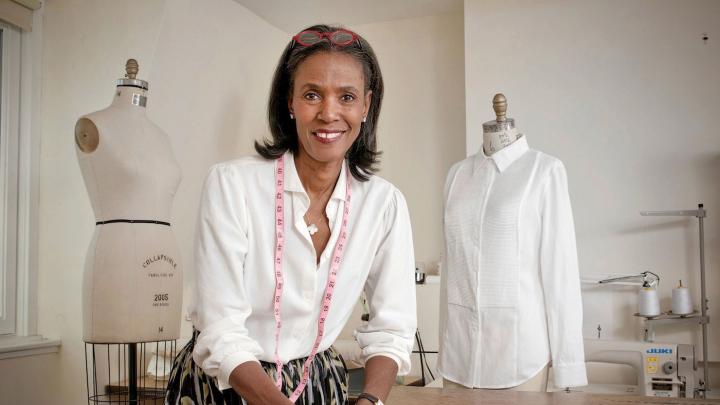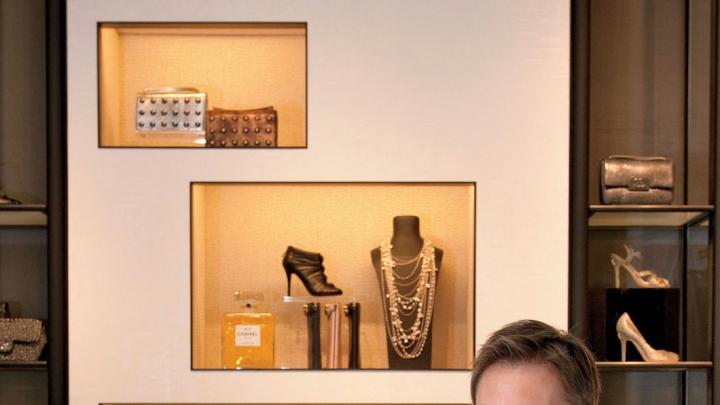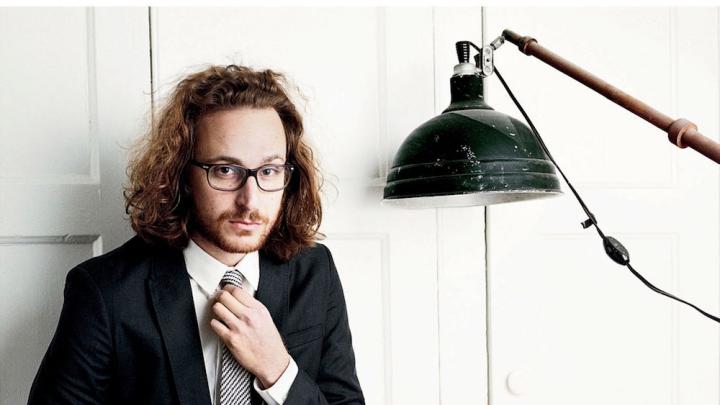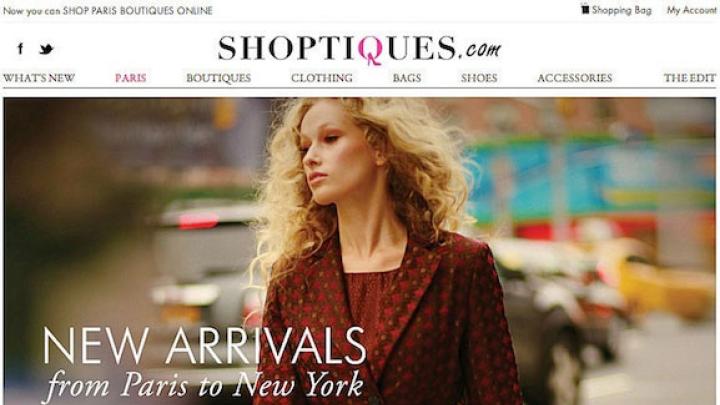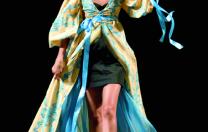Though the early April night is freezing cold at 10 p.m., a line of 600 people, mostly students, waits more than 40 minutes to enter Annenberg Hall. They are another sellout audience for the annual Identities fashion show at Harvard. Four thousand more will watch online. Founded by undergraduates of Asian descent in 2006, Identities has evolved into a multiracial, multiethnic event. Each year, it presents an award to an accomplished fashion designer (also, typically, of Asian descent), like Vera Wang or Anna Sui; the 2012 honoree is Jen Kao.
Inside, alluring models sweep down a runway between the spectators—the first segment plays variations on the classic little black dress. Live video piped to a Jumbotron provides enhanced views for the enthusiastic audience. The male models have their own vocal claque of guys who cheer them on with frequent shouts of “ Woo! Woo!” And many spectators—in high heels, décolletage, short hemlines, and glittering fabrics—are as well turned out as the runway models.
“Harvard is the only university with three fashion shows,” says Jane Chun ‘12, who last year, with Angela Su ‘12, headed the Vestis Council, an undergraduate organization that works year-round, in Chun’s words, “to promote fashion at Harvard as an aesthetic, creative, and professional interest.” (The annual Eleganza show, founded in 1994 by the umbrella organization BlackC.A.S.T., draws as many as 2,000 to its sexy, dramatically choreographed spring events, and the Retail and Luxury Goods Club at Harvard Business School [HBS] has mounted an annual fashion show since 2008 that, like the others, raises money for charities.) “In the last five years, there’s been a surge of interest in fashion,” Chun declares. “Our dream is to develop a liaison between the fashion industry and Harvard.”
That dream, in fact, is already a reality. In recent decades, dozens of Harvard alumni have taken influential roles in all facets of the fashion industry: as designers, models, executives, and entrepreneurs.
Here are some of their stories that, taken together, refract an image of the fashion business through a Crimson lens.
The aesthetic sensibility of Gabrielle “Coco” Chanel (1883-1971) still infuses her company, which began in a Paris boutique she opened in 1910. A 2011 HBS teaching case, “Coco Chanel: Creating Fashion for the Modern Woman,” by Mukti Khaire, associate professor of business administration and Kerry Herman, associate director of the Business School’s Global Research Group, quotes Chanel’s declaration, “Fashion is not simply a matter of clothes. Fashion is in the air, borne upon the wind.” She may have taken this dictum literally: her legendary No. 5 perfume appeared in 1921.
“Coco created the codes of Chanel, the enduring framework of the brand,” says John Galantic, M.B.A. ‘90, the New York-based president of Chanel US since 2006. “There is a visual vocabulary: the tweed jacket, the black-and-white colors, the camellia, the No. 5 fragrance, the quilting and chains in our handbags, the little black jacket. Karl [Lagerfeld, Chanel’s fashion designer since 1983] plays with that vocabulary and reinvents it, sometimes irreverently, or even challenges it, but those codes remain vibrant and provide a sense of continuity. They remain very much a part of the House of Chanel and are reflected not just in clothing but in our fragrance, makeup, watches, and so on.” Coco Chanel, he notes, “was a female entrepreneur at a time when there were none. Most brands are named after men. She grew up in an orphanage and created what is arguably the most desired fashion label. It gives us a connection with women, both as customers and employees.”
Chanel is privately held—”a significant advantage, and a reason for our success,” says Galantic, who spent years in Europe managing portfolios of brands for private and public companies like Coty Beauty (“I admired Chanel then, as a competitor”), SmithKline Beecham, and Procter & Gamble. “Public companies can be very driven by quarterly numbers,” he explains. “It’s much harder to think about the long-term health of the brand over a 10-year period when you’re public. Our ability to say ‘No,’ or ‘Not now,’ is an integral part of the Chanel brand remaining as pure, exclusive, and rarefied as it is.”
Other Harvardians have also helped build or sustain deluxe fashion brands. Domenico De Sole, LL.M. ‘72, an Italian-born tax attorney, took charge of Gucci, a cratering luxury-goods house, in 1994. He led a spectacularly rapid turnaround, appointing young designer Tom Ford as creative director, shaking up management, and repositioning the brand. The late Marvin Traub ‘46, M.B.A. ‘49, was a legend in fashion retailing; as CEO of Bloomingdale’s from 1978 until 1992, he transformed that department-store chain into a fashion powerhouse.
In the intensely competitive, data-based, mass-market world where Galantic worked before Chanel, powerful retailers like Walmart can determine a brand’s future. Now, he’s in a different landscape. “In luxury fashion, the major brands can control much of their own distribution, through their own stores and boutiques,” he says. “I’d rather control my brand’s presentation than trust that to a third party—it’s a more cohesive and stable business model. I prefer to be focused on things that add value to my brand than on pleasing—short term—a mega-retailer.”
Vertical integration enables Chanel to remain “very much focused on quality, from beginning to end,” he explains. Owning the early points in the supply chain helps. A few years ago, for example, Chanel bought nine “ateliers d’arts“—specialist suppliers to couture houses, such as the Lesage embroiderers—to ensure the availability of their work, as some were financially vulnerable. Galantic’s training took him to the harvest in Grasse, France, where Chanel grows roses and jasmine that go into the No. 5 fragrance. He says that his parents, Ivan Galantic, Ph.D. ‘69, and Elizabeth Joyce Galantic, Ph.D. ‘82, who taught art history and English literature, respectively, instilled in him an aesthetic sensibility. “In a world where there’s a lot of cutting corners and mass production, I find an intrinsic value in being obsessively focused on the highest quality and design standards and continually raising the bar—whether it’s the clarity and cut of diamonds, or the exotic skin of a Chanel handbag,” he says. “There are not many companies left that have that kind of focus. Ultimately, we’re more about creating fine products and less about the way they’re marketed.”
The bulk of Chanel’s business in its three divisions (fashion and accessories, watches and fine jewelry, and fragrance and beauty) goes through its own boutiques. It also sells fragrance and beauty products in stores like Saks Fifth Avenue, where Steve Sadove, M.B.A. ‘75, has been CEO since 2006. “Fashion is a combination of art and science,” Sadove says. “You want to anticipate consumer tastes, and you’re also helping to drive consumer tastes.”
“Knowing your customer” in a mass-market context means distilling a profile from aggregate data, but in a high-end boutique, the staff know the customer by name, and know her family members and tastes. Today, e-mail, texting, or Facebook postings can speed that personal contact. Hence, “a Chanel boutique director might attend a runway show in Paris and say, ‘Mrs. So-and-so would love that, and so would her friends,’” says Galantic. “It gets down to that level of granularity. A fine luxury experience is a personal one.”
When her father, a former Ugandan ambassador to the UN, died in 2006 at age 93, his passing conveyed a carpe diem lesson to designer and entrepreneur Katiti Kirondé ‘79: “Now is the time to do what you’ve always wanted to do. I had always wanted to do white shirts for women—to do what Vera Wang did for wedding dresses: bring style and fashion to them.” Her mission to feminize the crisp button-down shirt—using design elements and principles like tucks, fit, and line—has produced a collection of more than two dozen styles for her Katiti label (www.katiti.com), rendered in all-natural fabrics: cotton, linen, or silk. “They are things you could wear with black pants, jeans, cigarette pants, or a simple skirt,” she says. The shirts come from Kirondé’s firm, Tortue, Inc. (the French word for tortoise, chosen for its “slow and steady” connotations), a partnership between the designer and her husband, architect William Winder.
In 1968 Kirondé appeared on the cover of Glamour magazine, becoming the first black woman on a major American fashion-magazine cover. She began college in her mid twenties, while a young mother; as a parent of three youngsters, she designed children’s clothing for her own firm, Boston Bred. She segued into design and product-development jobs with the House of Bianchi, Laura Ashley, and David Brooks in Boston, plus freelancing for Talbots.
Beginning in 1996, her children grown, Kirondé spent 13 years with the Framingham, Massachusetts-based TJX Corporation, parent company of the clothing retailer T.J. Maxx. There, she designed women’s sweaters and, as a design manager, traveled throughout Asia (Hong Kong, Korea, Indonesia, and China) and Europe (Spain, Italy, France, and England), looking for trends and spotting items like new yarns. “I felt like I was always traveling,” she says. “But the things I learned at TJX and the contacts I made were invaluable.”
Some of those contacts helped her begin manufacturing Katiti shirts in China. She hired Mike Dolan, a “sourcing person,” to identify sources of fabric, factories, and other production necessities, as she was weary of travel and wanted to focus on design. Shirts reached stores in the fall of 2010, concentrated in Boston boutiques, where they retailed in the $225-$300 range. “ Right out of the box, we got good press,” Kirondé says: favorable notices appeared in The Boston Globe, Boston Magazine, The Huffington Post, and among fashion bloggers. Boston Magazine cited the shirts’ “rarely seen attention to detail: delicate ruching, exquisite collars, perfect pleating—all in subtly feminine cuts. The result is both timelessly elegant and unapologetically stylish.”
Yet scaling a fashion business is a challenge. The factory in China said, “’We want bigger numbers,’” Kirondé explains. “They’re not interested in making hundreds of shirts—they want to do thousands. But without big retail stores, it’s hard to make those large numbers. We haven’t done spring collections because, for a small label, there’s not enough volume to do spring.” Tortue plans its next collection for the fall of 2013, using a New York City-based factory, but the product will become much more expensive, retailing in the $400 range.
Meanwhile, Kirondé is helping mentor the next generation of fashionistas; she teaches a fashion course at Fisher College in Boston, has given presentations at Harvard on the topic, and has worked with the undergraduates who put on runway shows like Eleganza. She counsels them to cultivate persistence. “Young design people call me and are very discouraged,” she says. “They feel, ‘I’ve got this incredible product and everyone is going to love it.’ Then that doesn’t happen. People don’t even return your phone calls. You can’t be embarrassed about calling over and over again. A hurdle is actually a step to the next thing.”
When he finished his senior thesis film in visual and environmental studies, Alexander Olch ‘99 designed a souvenir for each member of his production crew—a handmade tie. He soon learned how difficult tie-making can be: it took 18 months for him to finish the first tie based on his design.
Olch is still making films (including a documentary on his mentor, Richard Rogers; see “The Windmill Movie,” May-June 2009), and is finishing a feature-length screenplay. And a personal note still runs through Alexander Olch, LLC, which sells handkerchiefs, suspenders, and scarves as well as neckties and bowties. At Harvard, he’d been a stylish undergraduate who “wore a tie every day for four years” and once, at a Halloween party, encountered three friends costumed as him (“and there were only two Marilyn Monroes,” he notes).
In the fall of 2001, Olch dined with four well-paid classmates in New York and showed them a sample tie he had made: he sold four at $100 apiece. He next sold out a run of eight, then 16, as word of mouth spread to friends of friends. In 2003 he set up a website to sell his ties and in 2005 The New York Times Style section called one of them—a classic red seersucker—the number-one tie to buy for Father’s Day. Business took off.
In 2007 Olch took a small collection of 24 ties, arranged in two desk drawers, to Bergdorf Goodman; they took him on. Today he has 50 accounts worldwide, including Neiman Marcus and the online haberdashery MrPorter; neckties sell for $150, bowties for $110, and scarves for $200 to $350.
He describes his collection’s look as “relatively personal, connected to my life. I grew up on the Upper East Side in a fashion environment saturated with the New England prep style. After college, I returned to New York, but lived downtown. So my life is a mix of uptown and downtown: I like playing with the idea of classic in a more adventurous way. For example, the shop colette in Paris, which many consider the most fashion-forward store in the world, sells my ties, and they are also on the first floor at Barney’s.”
Olga Vidisheva, M.B.A. ‘11, was working 120-hour weeks as an investment-banking analyst at Goldman Sachs in New York, “sleeping on the floor of my office.” Exhausted even while on vacation in Paris, she “staggered into a boutique where I bought a pair of Phoebe Cham Pour Schu flat shoes. Everybody complimented me on them—/ I wanted more! But I didn’t travel often, and couldn’t go back to Paris. I thought, this is the twenty-first century—why can’t I go back there virtually?“
Vidisheva left Goldman Sachs to enroll at HBS. “I realized I’m not interested in doing deals,” she says. “I wanted to run a business—to strategize, to grow the business. I want to be the doer, not the adviser.” In her second year, she was president of the school’s Retail and Luxury Goods Club and developed her Paris idea into a business plan for Shoptiques.com. It launched a few months after she graduated. Shoptiques sells fashion clothing and accessories from more than 180 small boutiques across the United States and in Europe. “Thirty-five to 40 percent of all transactions in this [fashion] sector happen at small retailers,” Vidisheva says. “Apply that to the online world, and you get a $20-billion market.”
“Our clothing is produced in very small quantities,” she explains. “There might be only five copies of this dress—a lot are one-of-a-kind. We do breadth, not volume. With mass-produced goods, you see everybody wearing the same thing. Celebrities come to our site, even though the price points are only in the $50 to $400 range, because we are unique—you will never end up in ‘Who Wore It Better?’” (The Us magazine feature compares celebrities sporting identical designer outfits.)
“The consumer wants all the boutiques to be available in one place—a lot of dresses, shoes, bags,” Vidisheva continues. “A woman in Kansas who has been watching Sex and the City for 10 years can travel virtually to New York City and shop in Nolita like Carrie Bradshaw.”
Shoppers used to insist on trying on garments—especially shoes—b efore buying. Now, consumers “will use the Internet as a dressing room,” says Saks’s Steve Sadove. “Someone will order a dress delivered in sizes eight and ten, try them both on, and return the one that doesn’t fit as well.” Websites like Shoptiques.com can display high-quality photographs and videos of garments, shoes, and accessories. “We do a really good job of describing things—and you can zoom in on dress details,” says Vidisheva, “so we get low return rates.” Comments from women who’ve tried on the garments in stores appear as well.
Born in Kyrgyzstan, Vidisheva came to the United States at 17, speaking no English. She had modeled in Russia (she was on the cover of a teen magazine) but says that the mentality there “ suppressed individuality. They wanted people to dress identically, to wear a uniform. Clothing should be a way to make an individual statement.” She enrolled at Wellesley, majoring in economics, and helped finance her education by modeling all over the United States. She calls the work “well paid and flexible. I’d be studying for school while they were doing my makeup. My modeling experience is vital for managing Shoptiques.”
One synonym for the American fashion industry is “Seventh Avenue”/ —a Manhattan business district focused on the clothing trade. Historically, Paris was where fashion design happened; New York was home to the “garment industry.”
Today, fashion is a multifaceted, complex, ever-changing global industry with new business models springing up almost daily and an ever-growing fraction of sales transacted over the Internet. “With its presence everywhere, every day, and its increasing growth and influence, fashion is less and less a ‘niche’ specialty,” says professor of law Jeannie Suk (see “ The Study of Fashion”). “It is easier now for the general culture to have a natural schooling in fashion, in what people are wearing. Everyone participates in some way: you put something on your body that expresses something about who you are. A little while ago, many people at Harvard could say, ‘I know nothing about fashion,’ and even be proud of it. That has become less and less the case.”
